Presentation of Experiments
At the very first beginning of doing experiments, we felt a little bit stuck since we could make decisions on what we should do for our final project. The case of Sproutworks is very unique, they have a very strict set of rules, and their working schedule is very much in order, during the conversation with them, most of the ideas they put forward are about the garbage classification problems and metal cups’ recycling problems that they identified in this campus. However, based on the course initiatives mentioned from the start of the semester, we believed that we should design something for the staff, therefore, we continued meeting with them, making observations during their working shifts, and asking them for more information. That process lasted for a long time. Since we had not finalized our project proposal, we could only do the experiments with materials that we possibly would use. Later on, we finally had a rough image of what we are going to do, back support for the Sproutworks staff.
In order to make back support, we need several elements, things to support the weight, joints that connect the back to the stool, and the back. For the back, we do not want to make a still one, instead, we want to design some shapes that can be comfortable for the users. However, making a back with curves requires a lot for making the modes. Then, we thought of making a cushion to make the back support softer, however, then the back support would be hard to fold, which violates our initiative of designing that. Finally, inspired by professor Marcela, and based on some researches that we did, we decided to use webbing technology to make soft, recycled-plastic-made stool back support.
Plastic bags:
We tried to master how to make several layers of plastic bags flat enough with the use of a heat press. From the observation in lecture experiments and our own experiments, we found out that it is hard to make layers of plastic bags flat using the heat press.
Foams:
We tried to add some foams into the plastic bags to make the materials softer and flatter.
Experimentation on the backrest
We pick to webbing technique overwrap or cross. Since this will minimize the number of plastic bags or foams needed, and we do not have too many in the trash. Webbing also provides the flexibility needed for the backrest.
Fails: with only plastic bags, the back doesn’t have the necessary stretch or flexibility, this affects the comfort and also the aesthetics of the chair.
Solution: adding two layers of foam on front and back provides a bit of “cushion” to the structure, and enhance the flexibility of the web.
We also experiment with the temperature of the pressing machine to create a better structure.
Overall: the webbing technique helps turn something that looks more fragile and like waste into a pattern that could be a part of a new product like a backrest. We are still finalizing the design, so we could move on to experiment with the stem, etc
To make webbing, we tested which width would be the best suit for our project.
Here is the lab report.
After we received the feedbacks for our presentations, we decided to work on a few more experimentation for the backrests’ sustainable material:
This time, we didn’t mix different types of plastics, since it won’t be recyclable after usage: so we made three types of the press: plastic bags(HDPE), “smoother” plastic bags(LDPE) & foam.
So for HDPE, it was the most common cause for grocery bags like ‘Hema’, the polymers are in chains and floats parallel to each other. As there is very little branching, there is not a lot of stretching for them, even when we heat press it at around 180 degrees. After heat-press, the 5 layers of HDPE also become the thinnest in our experiment (plus it has the least flexibility).
For LDPE plastic bags, we tried the mall’s supermarket bag, they felt smoother in texture since the polymers are in branches. After heat press at a similar temperature, it melts similarly to HDPE plastic bags, but it has a more distinct texture and could be smoother if we smooth out every layer. It also has a bit more flexibility, we will possibly use this material for our later prototype for webbing.
And for the foam, we understand that it will not be recyclable after heating, but we decided to experiment with it. Foam has a higher melting point, so we try 220 degrees, with a similar number of layers (5). Foam requires a lot less heating for it to melt, and the final result provides a smooth and interesting pattern. It has a leathery feel for the material, while it might not be sustainable, but it can be an option if we have a lot of foam trash in storage.
Something in common: for each layer to truly compress and mix, the final material will be very thin nonetheless how many layers we added. (we find that 5 or 8 layers create similar thickness at the end.)LDPE plastic bags will be most suitable for webbing.
For the next step, we want to create 4 sheets of LDPE and create webbing strips that are about 40 cm in length and 2.5 cm in width. We find 2.5 cm to 3.5 cm in width would work.
Experimentations after presentation
foam with three layers of plastics in between => webbing experiment
We’ve found that the Tmall supermarket plastic bag performs best (provides the texture/surface we desired) from the different plastic bags comparison from last week. So this week, I did further testing specifically on the Tmall bag( I believe it is LDPE, as it has the same texture as the Watson bags, but it doesn’t say what kind it is…) and use a regular HDPE pet2 bag from Aldi. While the melting point for plastic bags is around 130 degrees, we find any temperature under 160 simply cannot fuse the plastic bags properly.
At 145 degrees, while the plastics fuse in certain areas, it is largely un-attached.
At 175 degrees, this specific kind of Tmall bag melts perfectly, but it kind of “over melt” a bit, similar to the example of 185 degrees. Especially, when heat pressing larger bags, we need two times of 10 seconds heat-press, which mean higher temperature like 180 -190 would cause “over melt”, a texture that we don’t desire for our chair back, we want a smoother surface.
On the standard type of HDPE bag from Aldi, it is harder to fuse even at higher temperatures like 160+ degrees, there are many bubbles after the heat-press, possibly due to its polymer organization. Generally, the bag is harder to melt and fuse.
I tried varying the heat press time from 10 seconds to 20 seconds, while it is also a variable for the final result, I find the temperature has a greater effect on the heat press rather than the seconds on the machine.
One thing to note, after the experiment, it is crucial to have smooth baking paper. I tried one paper with a crease on it, and the result has the same mark on the plastic. It is important to get the details right to perform a smoother plastic material for the backrest.
On several layers:
While each layer of the Tmall plastic bag is relatively thick compare to other supermarkets, two layers of plastic bags seem a bit insubstantial and don’t have the leathery feel we tried to achieve. Four layers of plastic bags provide a solid layering. I tried to fuse two plastic bags each, then combine the two different layerings into one four layers plastic sheet. It has good strength, quite surprising flexibility, and the plastics hold together very well after melting at 165 degrees for 10 seconds x 2 times. If we can have more plastic bags available, I will try six to eight layers in the future, given we have enough bags.
Adding colors:
Due to the pattern on these plastic bags, I tried a few different methods to redo the appearance of the sheets. First, I tried spray paint, while it covers the bags’ logo, it adds more weight to the material, and its liquid status might alter the shape of these sheets, make it appears with more creases. But it does add a leathery feel to the plastic sheets. The matte finish also contrasts with the melting plastics’ original texture. We might try paint later on, as spray paint might be a bit too thick and uneven at places.
On the final result:
We will try to webbing technique on both the two layers and four layers of the Tmall bag, both perform better than I expected and has a better presentation than most other plastic bags, such as Aldi’s, where creases is a major issue. We will move forward with the Tmall bag, by pressing two layers of plastic sheets together each time, then build up from there. 165 degrees for 10 seconds x 2 times (times it needed to merge with other layers) is the solution for this type of bag.
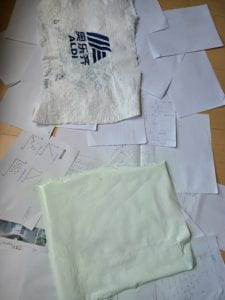

Next Steps:
Test the solid plastics materials, make modes, and try to produce the back supporting sticks and clamps with solid plastics.
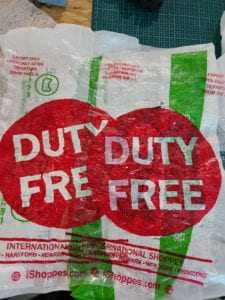
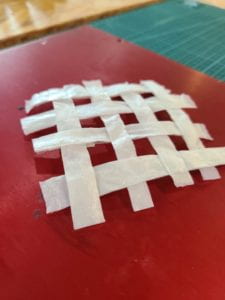
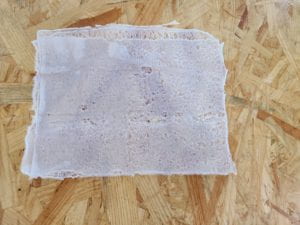
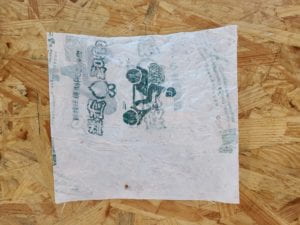
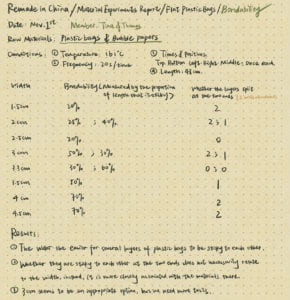
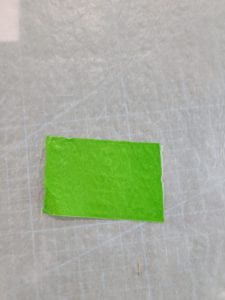
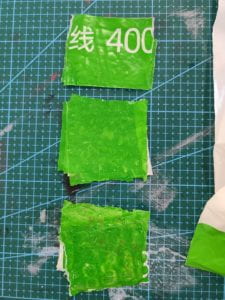
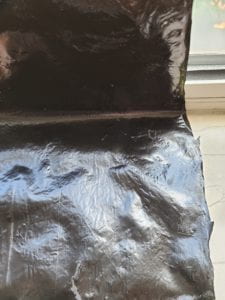
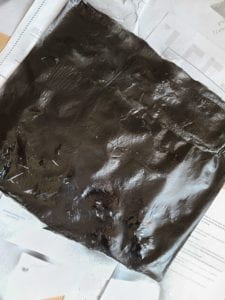
Leave a Reply